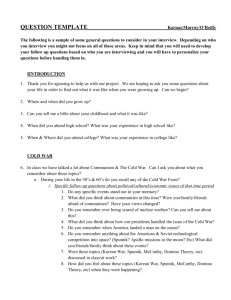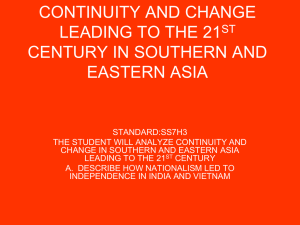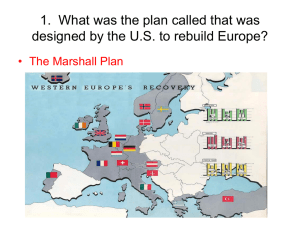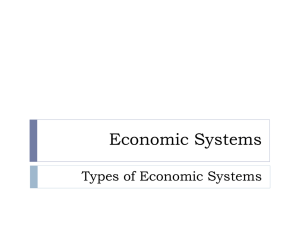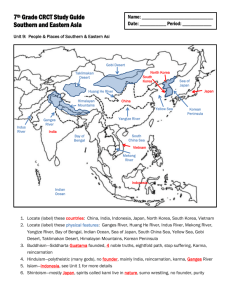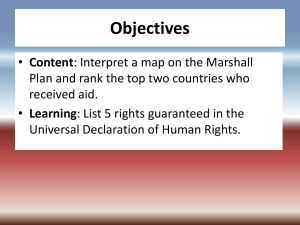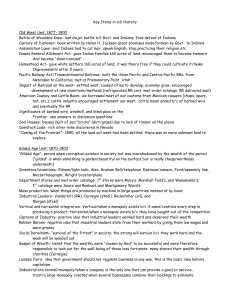Name US History II Final Review: Exam JUNE 5TH 8am Roaring
advertisement
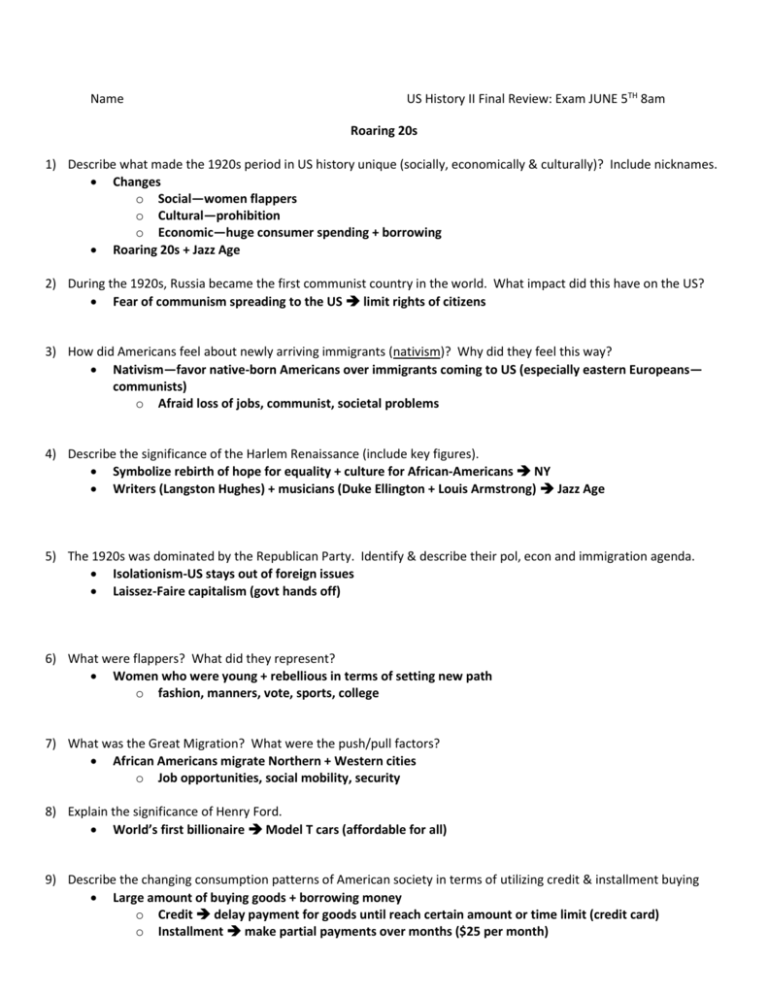
Name US History II Final Review: Exam JUNE 5TH 8am Roaring 20s 1) Describe what made the 1920s period in US history unique (socially, economically & culturally)? Include nicknames. Changes o Social—women flappers o Cultural—prohibition o Economic—huge consumer spending + borrowing Roaring 20s + Jazz Age 2) During the 1920s, Russia became the first communist country in the world. What impact did this have on the US? Fear of communism spreading to the US limit rights of citizens 3) How did Americans feel about newly arriving immigrants (nativism)? Why did they feel this way? Nativism—favor native-born Americans over immigrants coming to US (especially eastern Europeans— communists) o Afraid loss of jobs, communist, societal problems 4) Describe the significance of the Harlem Renaissance (include key figures). Symbolize rebirth of hope for equality + culture for African-Americans NY Writers (Langston Hughes) + musicians (Duke Ellington + Louis Armstrong) Jazz Age 5) The 1920s was dominated by the Republican Party. Identify & describe their pol, econ and immigration agenda. Isolationism-US stays out of foreign issues Laissez-Faire capitalism (govt hands off) 6) What were flappers? What did they represent? Women who were young + rebellious in terms of setting new path o fashion, manners, vote, sports, college 7) What was the Great Migration? What were the push/pull factors? African Americans migrate Northern + Western cities o Job opportunities, social mobility, security 8) Explain the significance of Henry Ford. World’s first billionaire Model T cars (affordable for all) 9) Describe the changing consumption patterns of American society in terms of utilizing credit & installment buying Large amount of buying goods + borrowing money o Credit delay payment for goods until reach certain amount or time limit (credit card) o Installment make partial payments over months ($25 per month) 10) Explain the significance of the Scopes Monkey trial. Debate between religion (creationism) vs. science (evolution) 11) Who did not benefit from the Roaring 1920s? Why? Farmers (over production) Minorities (less money + job opportunity) Growing gap between rich and poor 12) What was prohibition? How did Prohibition impact American society? Ban sale of alcohol Led to increase in crime + immorality Great Depression 13) Describe the causes of the Great Depression? Bad banking = bankrupt o Speculation buy/sell risky stocks o Buying stocks with credit = debt Borrowing practices = debt (installment) Overproduction of consumer goods (too much supply = decrease in prices) Majority of Americans poor 14) How did the Republican President, Hoover, initially respond to this crisis? Do nothing economy will fix itself blamed for making crisis worse 15) During the 1930s, President FDR attempted to restructure the Supreme Court. What was this called? Why would he want to do this? Why did Congress & Supreme Court resist this change? Supreme Court overturn New Deal—unconstitutional (increase Presidential powers) Court-packing (add 6 new judges) o FDR wanted his New Deal laws to be legal Congress resist destroy checks + balances of government (president too powerful) 16) Describe the lasting impact FDR’s New Deal legislation had on relationship between the American public & govt. FDR presidency o Govt responsible for nation’s success o Federal govt increase in power 17) How did the US get out of the Great Depression? US gets involved in WWII 18) Besides the financial crisis, the US was also affected by the Dust Bowl? What was the Dust Bowl and describe its impact on western farmers. Dust Bowl drought + dust storms destroy farms + houses out West o Millions migrate West for work 19) Describe the significance of Black Tuesday. Biggest stock market decrease in US history World War II 20) Describe US foreign policy post WWI until 1941. Isolationism stay out of foreign alliances + issues 21) How did WWII happen? Treaty of Versailles (punish Germany) Appeasement give Hitler what he wanted to avoid war o Munich Agreement Hitler gets land in exchange for no more aggression 22) Describe totalitarianism. Dictatorship Hitler + Stalin 23) Describe how leaders like Hitler, Mussolini & Tojo came to power in their respective countries. Promises and successfully fixes country’s problems economy Strong sense of nationalism (pride in country) + resentment (against Treaty of Versailles) 24) Why was Japan becoming a major concern for East, Southeast Asian countries as well as for the US? Desire for natural resources (oil) + imperial power (take islands) 25) Explain the significance of Rosie the Riveter. Represent power and strength of women use to recruit women workers for industry 26) Explain the significance of the Korematsu v. US Supreme Court case and its impact on Japanese-Americans. Nativism, racism + prejudice can overrule constitutional law o Deny freedoms during war time o Japanese-Americans lost everything during war—homes + businesses 27) Describe the significance of the Final Solution & the Holocaust. Final Solution Eliminate Jews Holocaust mass killings of undesirables 28) How did the US come to the decision to drop two atomic bombs on Japanese cities? Invasion would cost too many lives 29) How did the US and world change as a result of the conclusion of WWII? Creation of United Nations—world peace-keeping organization US becomes world power involved in foreign affairs Cold War over world supremacy (US + Soviet Union) The Cold War & 1950s America 30) Describe the origins of the Cold War (in Europe). Soviet Union takes over Eastern European countries—makes them communist 31) Define the following Cold War concepts/incidents a. Truman Doctrine—promise help to countries fight to keep democracy (Greece) b. Marshall Plan—give western Europe $13 billion to fix countries (prevent communist takeover) c. Berlin Airlift—US air-force drop supplies into Berlin over Stalin’s blockade d. Containment—stop spread of communism e. Domino Theory—if one country falls to communism others will too (Asia) f. Iron Curtain—split Western (democratic) vs. Eastern Europe (communist) 32) The 1950s can be described as the ‘Age of McCarthyism.’ What does this mean and how did it impact American society? Reckless communist charges which ruined lives + limit civil freedoms o Blacklist—prevented from working (suspect) Fear that communists had infiltrated the US govt 33) The US was locked in a stalemate with North Korea/Chinese communist forces. General Douglas MacArthur wanted to bomb and blockade China. Why did President Truman not agree? Didn’t want Soviet Union to enter war = WWIII 34) Describe US foreign policy post WWII. Give 1-2 examples. Involved in world affairs o NATO—world alliance vs communism o Cuba tried to overthrow communist govt (Bay of Pigs) 35) How did McCarthyism, HUAC, and Loyalty Oaths impact the US constitution & Bill of Rights? Limit freedoms speech, assembly + petition (Bill of Rights—1st amendment) 36) After WWII, what gains did African Americans make in terms of civil rights? Desegregate army 37) How were workers affected by the end of WWII? Many fired because peace-time goods (radios) easier to make than war goods 38) How were women affected by the end of WWII? What was the rationale used to justify this? Fired make room for returning soldiers (domestic work, Civil Rights 39) Define the following concepts/ideas regarding African-American oppression: a. Plessey v. Ferguson—‘separate but equal’ public facilities (justify segregation) b. Jim Crow laws—legalize segregation (schools, buses, intermarriage) c. Poll Tax—pay to vote d. Grandfather Clause—if grandfather could vote before 1867, you could vote e. Literacy Test—pass a reading/writing test to vote f. US v. Reese—States can’t deny vote based on race BUT CAN DENY IT FOR OTHER THINGS 40) What was the major goal of the Civil Rights Movement? End segregation 41) Define & Describe the following successes of the civil rights movement: a. Brown v. Board of Education (1954)—integrates public schools (ends separate but equal) b. Integration—mix blacks/whites c. Montgomery Bus Boycott 1955)—ends segregation on buses (started by Rosa Parks) d. Sit-ins—peaceful protest which desegregated lunch counters in restaurants e. Civil Rights Act 1964—states can’t use different voting standards for blacks/whites f. Voting Rights Act (1965)—ban literacy tests which prevent voting 42) How did the two biggest civil rights leaders, Malcolm X & Dr. MLK Jr., differ in their approach to civil rights? Dr. MLK Jr. civil disobedience (boycott, marches) Malcolm X aggressive + violent action 43) Explain the significance of Cesar Chavez. Improve hours, wages + conditions of migrant workers 44) Explain the growing civil rights movement for women. Title IX equal education + sports funding Equal Pay Act get closer to men’s pay ERA failed to pass (add gender to constitution) 45) In the 1960s, President Johnson was able to pass a bunch of legislation that resulted in a nickname known as the Great Society. Who did it help & and what was his connection to President FDR? Focused on poor + disadvantaged Great Society increased power of Presidency = President FDR Vietnam 46) Which foreign country ruled Vietnam? Why did they wish to maintain it as a colony post WWII? France Got rich by stealing valuable land + resources (rice + rubber) 47) How did the Vietnamese people feel about the French? Why? Hated French rule poverty 48) What are the two major reasons for US involvement in Vietnam? Containment + Domino Theory = spread of communism in Asia 49) Who was Ho Chi Minh? Communist leader of North Vietnam whose goal was Vietnam’s independence from foreign rule 50) As part of the peace treaty between France and the Viet Minh, national elections were to take place in 1956 to determine the political situation in Vietnam. Who was responsible for not keeping this promise AND why? Ngo Dinh Diem knew he would lose 51) Describe the fighting style of the Vietnamese and why this war was so different than other wars fought: a. Limited War—afraid of China getting involved (don’t go all the way) b. Geography—jungle + heat too much for tanks c. Guerilla Warfare—surprise tactics (come out of tunnels, booby traps) d. Civilian fighters—Viet Cong mix in with civilians 52) Why did the US government overthrow Ngo Dinh Diem’s government (previously backed by the US)? Corrupt govt Created Viet Cong—bad treatment of South Vietnamese people 53) Describe the significance of the Gulf of Tonkin Resolution. Increase President’s power over Congress (declare war) Escalation increase US military in Vietnam 54) How did the Tet Offensive impact the American public? Credibility Gap govt lied about progress of war 55) What is civil disobedience? Provide 3-4 examples that relate to protesting the Vietnam War. Non-violent protest against an injustice o Buddhists burning selves alive to bring attention to Diem’s corrupt policies o Burn draft cards o Refuse to report for military duty 56) What was Vietnamization? Gradual withdrawal of US troops from Vietnam + turn fighting over to South Vietnamese 57) Describe the outcome and significance of ending the Vietnam War in the US a. 26TH Amendment—change voting age to 18 (if can fight can vote) b. War Powers Act—limit military power of the President c. Credibility Gap—people begin to distrust govt War on Terror 58) Describe the relationship the US had with Osama Bin Laden prior to 9/11? US supported Bin Laden against Soviets in Afghanistan (Cold War) 59) What major events happened on 9/11? Pentagon hit by plane Twin Towers destroyed Flight 93 crashed in PA after passengers fought vs hijackers 60) Why did Islamic fundamentalists declare a holy war on the US? US forces in holy land US support Israel (enemy) US focuses on Middle East for personal gain—oil 61) What is the name of the terrorist organization which aligned itself with Al-Qaeda? Taliban 62) What major terrorist did we find and eliminate in Pakistan back in 2011? Osama Bin Laden
![vietnam[1].](http://s2.studylib.net/store/data/005329784_1-42b2e9fc4f7c73463c31fd4de82c4fa3-300x300.png)

